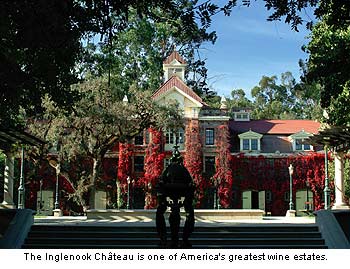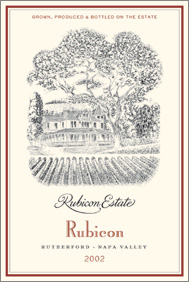
Larry Stone steps out of the restaurant limelight to take on the enviable position as General Manager of Rubicon Estate.
Rutherford ~ Napa Valley (AVA)
Finding the Terroir Character in the wines of Rubicon Estate with Larry Stone
by
Alan Goldfarb
September 6, 2006
Alan Goldfarb (AG): Tell me about the changes at Rubicon Estate (nee Niebaum-Coppola).
Larry Stone (LS): All of our resources are being rededicated to being an estate winery. The Coppolas think it’s one of the greatest estates in America. Inglenook made some great wine here. (And so) we’ve become more traditional.
We’re making Rubicon (Coppola’s signature Cabernet-based wine), here as well as CASK Cabernet in honor of John Daniels Jr. (the owner of Inglenook in its glory days in the 1940s-60s), Blancaneaux (Viognier, Marsanne, Roussanne, Chardonnay), Edizione Pennino (Zinfandel), and RC Reserve (Syrah).
AG: I can imagine that Coppola made the decision to separate the properties because he thought he was losing the image of a high-end quality producer. Perhaps he learned a lesson from what happened at Mondavi (in which the consumer may have been confused about the Robert Mondavi Winery making wines across the spectrum of the marketplace).
 LS: They were making 2,000 cases (here, of high-quality estate wine) but made wines from other places that took on a life of their own; and they detracted from the estate.
LS: They were making 2,000 cases (here, of high-quality estate wine) but made wines from other places that took on a life of their own; and they detracted from the estate.
AG: Tell me about the terroir of the estate.
LS: Terroir is very hard to define. Here it’s defined by its location. (Our locale) does give very specific characteristics to the wines. We have a mountain behind us – Mt. St. John. Our best sites – the Garden Vineyard and the Gio Vineyard – are located where the rock and dirt has fallen off the mountain…It’s a zone that is a rare and superb spot. … The gravelly-ness of the soil allows the rain to drain off.
AG: How does it manifest in the bottle?
LS: The wines have interesting intensity and classic structure. It’s been a learning process how to handle it, so that it’s not too intense and not too tannic. That’s the characteristic: intense, complicated wines with a great deal of structure. The wines are defined by the site.
When you taste the old Inglenook wines that John Daniels made, they have that structure. They have a unique sour cherry, violet, mineral component.
We’ve never tried to eradicate the history of this place. I have a picture of John Daniels Jr. looking down at me in my office.
AG: What’s the difference between the CASK and Rubicon and is the difference a function of terroir?
LS: Our CASK has more in common with the AVA than does Rubicon. CASK has a Rutherford profile, even though the vineyard is a couple of hundred yards away from (the Garden and Gio vineyards that make-up Rubicon). CASK and Rutherford wines in general, are fruitier. They are a little more open and accessible…It’s black fruit (Rubicon) versus red fruit – cherry, caramel, cocoa, toast. It’s also minerality vs. flattering texture, soft mouth-feel and openness. … I’d rather drink a young CASK, than a young Rubicon.
CASK and Rutherford wines in general, are fruitier. They are a little more open and accessible…It’s black fruit (Rubicon) versus red fruit – cherry, caramel, cocoa, toast. It’s also minerality vs. flattering texture, soft mouth-feel and openness. … I’d rather drink a young CASK, than a young Rubicon.
(Winemaker) Scott McCloud's challenge has been not to force Rubicon to become softer. That would be a betrayal of the terroir. With ’02, it was a landmark year in which we recreated open-top fermenters, and we handled the fruit in a different way, the way John Daniels did. We’ve become more traditional. It’s the first time that the wine has come to its full fruition (although McLeod’s been there for 15 years). We’ve got it into equilibrium (between fruit qualities and tannin structure).
AG: How much input into the wines do you have?
LS: I’ve worked with Scott for the last five years. I’m a big fan. I don’t make the wines, but I offer my insight into what he’s doing. I have no role in the winemaking except in the cheerleading section. I first tasted the wine in ’92 with Tony Soter, who was winemaker (at the time) and before I went to Rubicon (the restaurant).
AG: Take me through the Rutherford AVA in general terms.
LS: There’s a difference between the west side and the east side (with Highway 29 being the demarcation line). Here on the west side, it stays cooler in the afternoon. One gets morning sun and the other gets afternoon sun (east side).
Rutherford is not as hot as the northern end of the Napa Valley. It’s one of the best spots for Cabernet. It has good drainage and it avoids some of the strong afternoon winds. For the last 150 years it’s been a spot that is perfectly balanced for Cabernets.
AG: Are you saying that with your sommelier hat or your Rubicon hat, now that you’re working there?
LS: With my sommelier hat. It’s always been a great site. I don’t know a place where you can go back and taste wines from the 40s and 50s. They (the early pioneers) knew this was the place to grow Cabernet. This is the zone, in the mid-valley. They didn’t go down to Oakville, or up to St. Helena. And I say it as a student of terroir.
~ Alan Goldfard, Napa Valley Regional Correspondent
To comment on Alan Goldfarb’s writings and thoughts, contact him at a.goldfarb@appellationamerica.com
Larry Stone (LS): All of our resources are being rededicated to being an estate winery. The Coppolas think it’s one of the greatest estates in America. Inglenook made some great wine here. (And so) we’ve become more traditional.
We’re making Rubicon (Coppola’s signature Cabernet-based wine), here as well as CASK Cabernet in honor of John Daniels Jr. (the owner of Inglenook in its glory days in the 1940s-60s), Blancaneaux (Viognier, Marsanne, Roussanne, Chardonnay), Edizione Pennino (Zinfandel), and RC Reserve (Syrah).
AG: I can imagine that Coppola made the decision to separate the properties because he thought he was losing the image of a high-end quality producer. Perhaps he learned a lesson from what happened at Mondavi (in which the consumer may have been confused about the Robert Mondavi Winery making wines across the spectrum of the marketplace).
 LS: They were making 2,000 cases (here, of high-quality estate wine) but made wines from other places that took on a life of their own; and they detracted from the estate.
LS: They were making 2,000 cases (here, of high-quality estate wine) but made wines from other places that took on a life of their own; and they detracted from the estate. AG: Tell me about the terroir of the estate.
LS: Terroir is very hard to define. Here it’s defined by its location. (Our locale) does give very specific characteristics to the wines. We have a mountain behind us – Mt. St. John. Our best sites – the Garden Vineyard and the Gio Vineyard – are located where the rock and dirt has fallen off the mountain…It’s a zone that is a rare and superb spot. … The gravelly-ness of the soil allows the rain to drain off.
AG: How does it manifest in the bottle?
LS: The wines have interesting intensity and classic structure. It’s been a learning process how to handle it, so that it’s not too intense and not too tannic. That’s the characteristic: intense, complicated wines with a great deal of structure. The wines are defined by the site.
When you taste the old Inglenook wines that John Daniels made, they have that structure. They have a unique sour cherry, violet, mineral component.
We’ve never tried to eradicate the history of this place. I have a picture of John Daniels Jr. looking down at me in my office.
AG: What’s the difference between the CASK and Rubicon and is the difference a function of terroir?
LS: Our CASK has more in common with the AVA than does Rubicon. CASK has a Rutherford profile, even though the vineyard is a couple of hundred yards away from (the Garden and Gio vineyards that make-up Rubicon).
(Winemaker) Scott McCloud's challenge has been not to force Rubicon to become softer. That would be a betrayal of the terroir. With ’02, it was a landmark year in which we recreated open-top fermenters, and we handled the fruit in a different way, the way John Daniels did. We’ve become more traditional. It’s the first time that the wine has come to its full fruition (although McLeod’s been there for 15 years). We’ve got it into equilibrium (between fruit qualities and tannin structure).
AG: How much input into the wines do you have?
LS: I’ve worked with Scott for the last five years. I’m a big fan. I don’t make the wines, but I offer my insight into what he’s doing. I have no role in the winemaking except in the cheerleading section. I first tasted the wine in ’92 with Tony Soter, who was winemaker (at the time) and before I went to Rubicon (the restaurant).
AG: Take me through the Rutherford AVA in general terms.
LS: There’s a difference between the west side and the east side (with Highway 29 being the demarcation line). Here on the west side, it stays cooler in the afternoon. One gets morning sun and the other gets afternoon sun (east side).
Rutherford is not as hot as the northern end of the Napa Valley. It’s one of the best spots for Cabernet. It has good drainage and it avoids some of the strong afternoon winds. For the last 150 years it’s been a spot that is perfectly balanced for Cabernets.
AG: Are you saying that with your sommelier hat or your Rubicon hat, now that you’re working there?
LS: With my sommelier hat. It’s always been a great site. I don’t know a place where you can go back and taste wines from the 40s and 50s. They (the early pioneers) knew this was the place to grow Cabernet. This is the zone, in the mid-valley. They didn’t go down to Oakville, or up to St. Helena. And I say it as a student of terroir.
~ Alan Goldfard, Napa Valley Regional Correspondent
To comment on Alan Goldfarb’s writings and thoughts, contact him at a.goldfarb@appellationamerica.com














